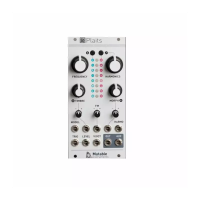An asymmetric triangle processed by a waveshaper and a wavefolder. Sounds familiar? That’s the same
signal processing chain as in Tides, when it runs at audio rate!
HARMONICS: waveshaper waveform.
TIMBRE: wavefolder amount.
MORPH: waveform asymmetry.
AUX: variant employing another wavefolder curve, as available in Warps.
Two sine-wave oscillators modulating each other’s phase.
HARMONICS: frequency ratio.
TIMBRE: modulation index.
MORPH: feedback, in the form of operator 2 modulating its own phase (past 12 o’clock, rough!) or
operator 1’s phase (before 12 o’clock, chaotic!).
AUX: sub-oscillator.
Note: turn MORPH fully CCW to get the same range of sounds as Braids’ WTFM. Turn MORPH fully CW
to recreate the same sounds as Braids’ FBFM. A gentler palette equivalent to Braids’ FM is found with
MORPH at 12 o’clock.
Simulation of formants and filtered waveforms through the multiplication, addition and synchronization of
segments of sine waves.
HARMONICS: frequency ratio between formant 1 and 2.
TIMBRE: formant frequency.
MORPH: formant width and shape. This controls the shape of the window by which a sum of two
synchronized sine oscillators is multiplied.
AUX: simulation of filtered waveforms by windowed sine waves – a recreation of Braids’ models.
HARMONICS controls the filter type (peaking, LP, BP, HP), with smooth variation from one response to
another.
Mutable Instruments | Plaits
4 of 11

